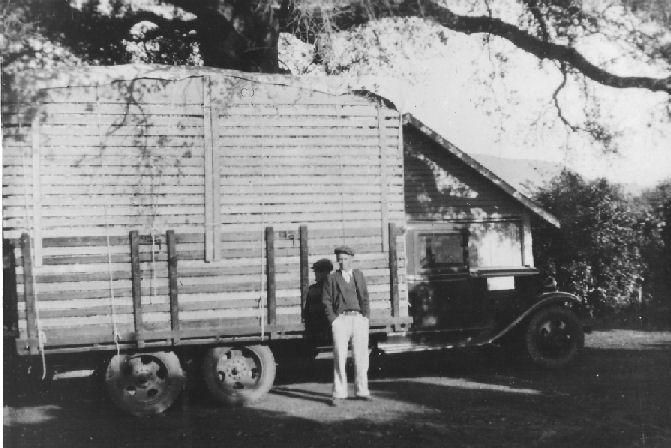
|
Subject: Stanley Ford and his new six-cylinder Chevrolet truck, about 1931.
Ford was in the trucking business in the Los Angeles Area.
|

|
Subject: Cowboys branding a calf on the Manse Ranch, probably in the 1940s.
|
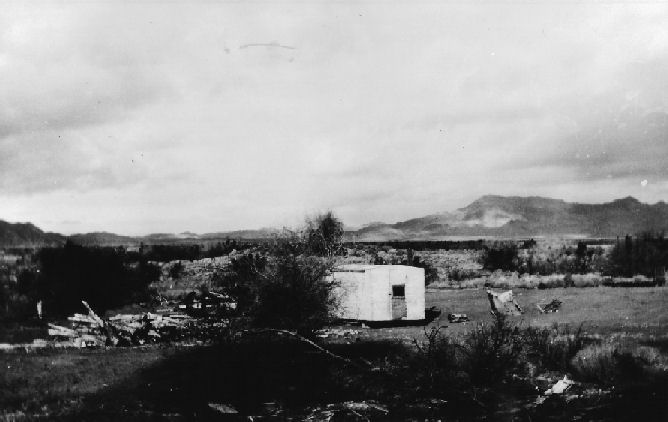
|
Subject: Looking west from the Raycraft Ranch, Pahrump Valley, Nye county, Nevada, around 1940. Cedar posts, on the left,
were cut in the Spring Mountain Range. Pictured is a four-wheel trailer constructed by Stanley Ford.
|
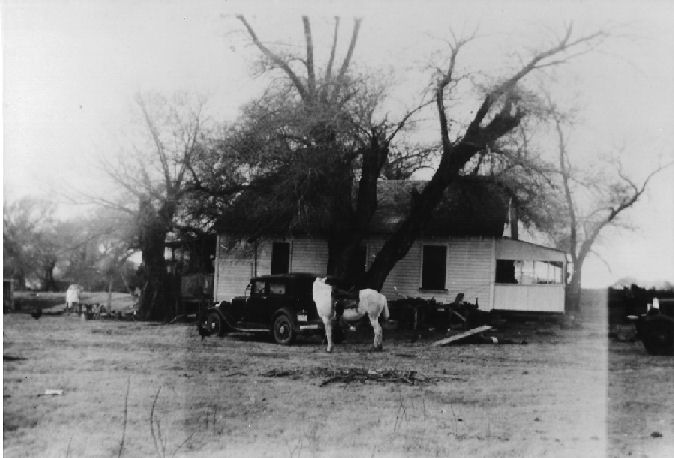
|
Subject: House on the Raycraft Ranch, 1945, looking west. the house was built by Jim Raycraft from lumber obtained at the
Johnnie Townsite and hauled down to Pahrump in wagons. The car is a 1931 Graham, used by Stanley Ford to haul mail to
Pahrump from the Johnnie Siding on the Tonopah Highway; the truck is a 1931 Chevrolet. It is said that during the summer
the house was mostly hidden by the large willow trees.
|
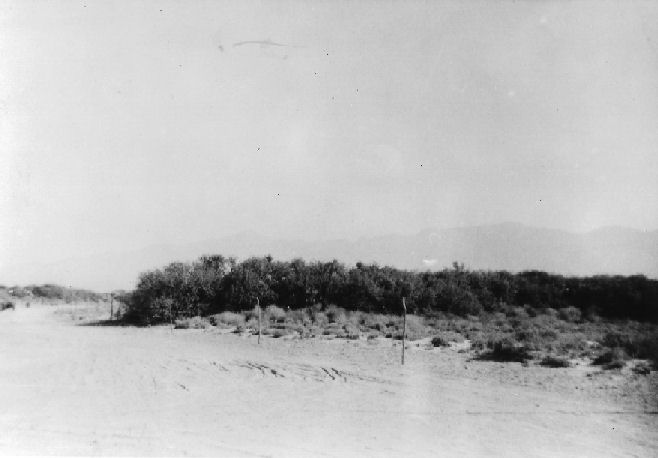
|
Subject: Look closely toward the middle of the photograph, about an inch above the mountain range,
and you'll see an atomic mushroom cloud from a test at the Nevada Test Site. Photo was taken from the front yard of Harry
Ford's home in Pahrump Valley, Nevada, looking north, a little east of Mount Sterling in 1952 or 1953.
|
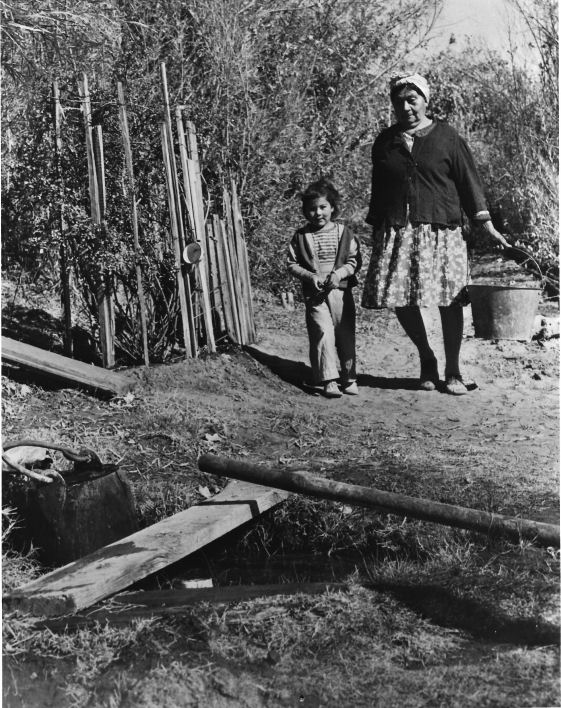
|
Subject: Dora Lee Brown and her granddaughter at Dora's place on the Yount (Hidden Hills) Ranch, Pahrump Valley, Nye County, Nevada, ca. 1940.
|
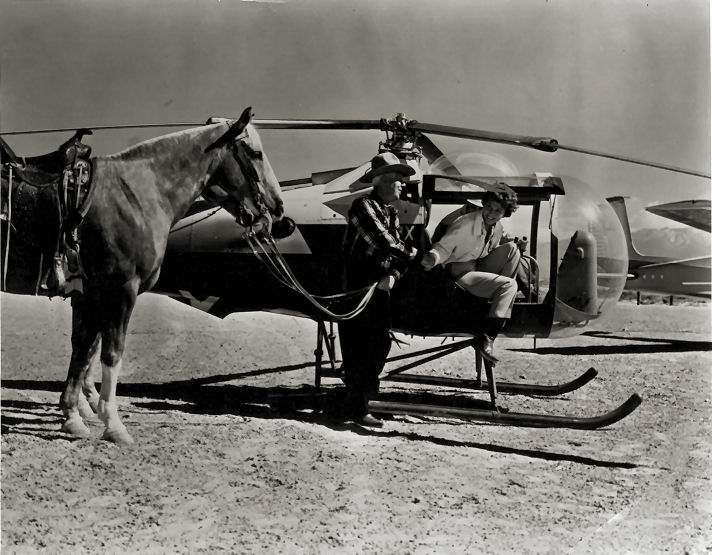
|
Subject: Hoot Gibson, a western cowboy actor, and Mrs. Elderbrook, then crowned Mrs. America, landing on Roland Wiley's Hidden
Hills Ranch airstrip, early 1950s..
|
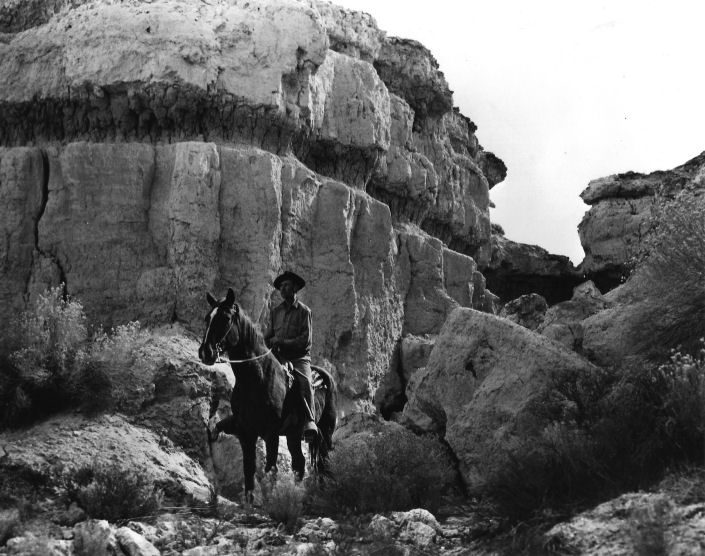
|
Subject: Fred Kennedy riding a gaited horse owned by Roland Wiley at Cathedral Canyon, Hidden Hills Ranch, Pahrump Valley, Nye county, Nevada, approximately 1939.
|

|
Subject: Cathedral Canyon in Hidden Hills ranch, Pahrump Valley, Nye county, Nevada, between 1950 and 1960. they typed caption on this photographs reads,
"Picturesque and widely known box canyon, now lighted and improved with lights, entrance baths, natural fireplaces,
recently named Cathedral Canyon because of its similarities to cathedral architecture. Located 150 feet from the famous
Hidden Hills Ranch and Cottages." Roland Wiley is on the left in the white shirt; Mr. Elderbrook, from Palm Springs,
is in the foreground in the white hat. Mrs. Elderbrook and Hoot Gibson's wife are also pictured. Probably 1950s.
|
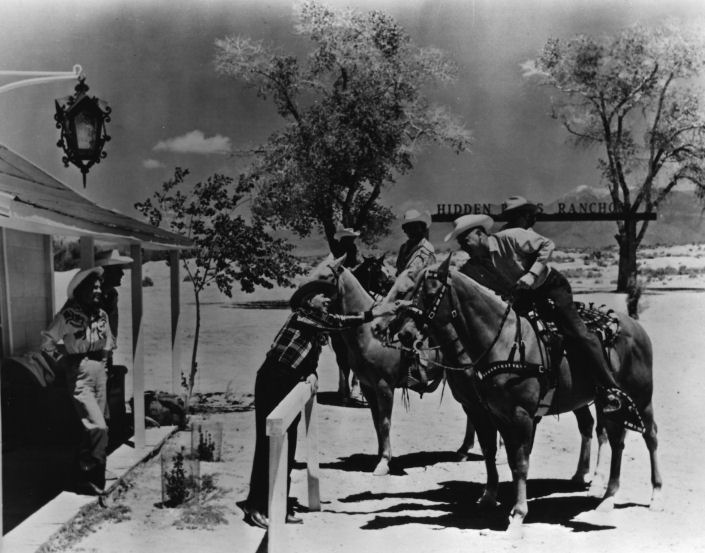
|
Subject: Visitors at the Hidden Hills Ranch during the 1950s. Hoot Gibson is standing behind the hitching post shaking hands with Murdell Earl, owner of the ENT Drug Store in North Las Vegas.
|
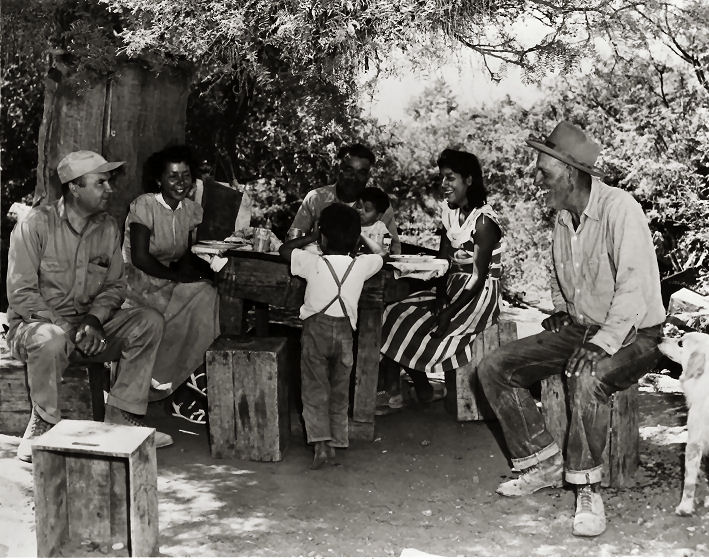
|
Subject: Roland Wiley is at the left and Elmer Bowman, owner of the Manse Ranch, is the far right, visiting Harry and Mary Sackett, an Indian couple who lived in a cottage on the Manse Ranch, ca. 1950.
|

|
Subject: Homestead house constructed on John Yount's homestead located at the south end of Pahrump Valley, Nevada. The house
looked pretty much as it does here when Roland Wiley acquired John Yount's ranch in 1936. The house was constructed of
2-by4s on 4-foot centers with the 2-by-4s standing sideways. In 1941, Roland Wiley removed the bat and board and installed
Johns Manville shingles. Wiley acquired John Yount's ranch from Belle Yount, common-law wife of John Yount, following John
Yount's death. On the left is a cherry tree that was watered by had from a well about 300 feet away.
|

|
Subject: In the years after Roland Wiley acquired John Yount's ranch in Pahrump Valley, Nevada, access was difficult.
From Las Vegas the shortest route was to drive through Goodsprings over a paved road, then to Sandy Valley, which was a
narrow gravel road; then to the Pahrump Valley and west on the Tacopa Road. The trip took 3-1/2 hours. Wiley notes that
from the ranch it was 7-hour round trip drive into Las Vegas to buy a 10-cent screw. In 1941, Wiley constructed the
airstrip pictured here near the ranch in order to make access easier. The photo is undated.
|
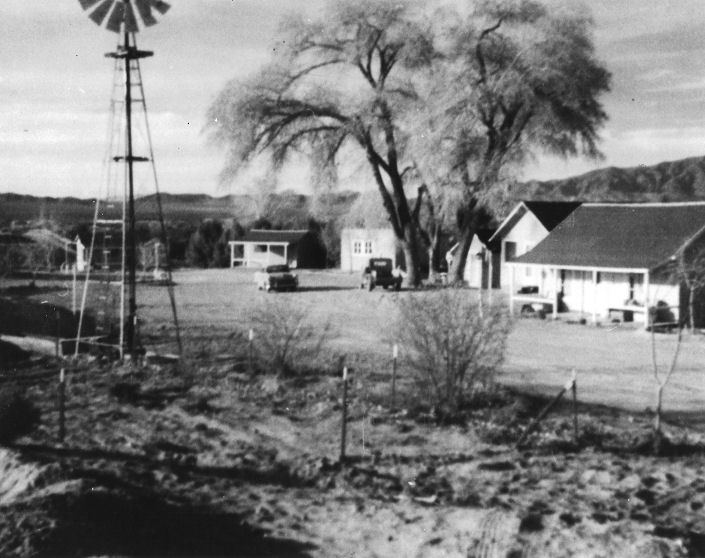
|
Subject: Cabins located on the Yount Ranch, Pahrump Valley, Nevada, 1950s. The cabins were constructed by Roland Wiley following Wiley's
purchase of the ranch in 1936. The last cabin was built in 1950.
|
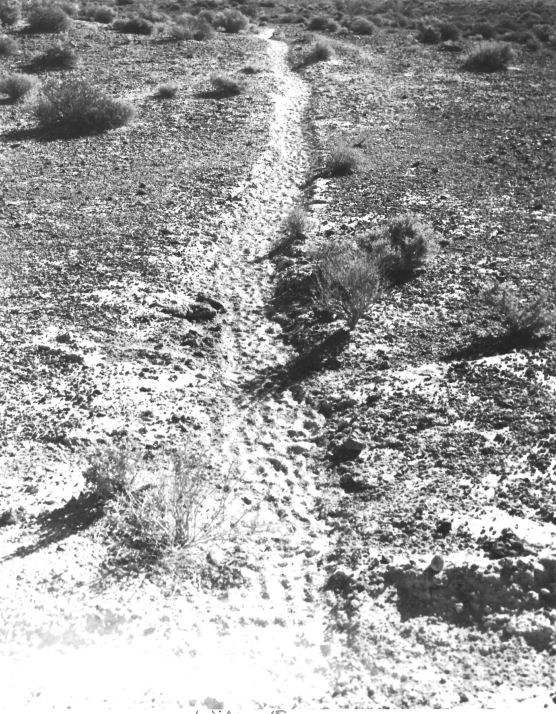
|
Subject: Cattle trails located on the Hidden Hills Ranch, Pahrump Valley, Nevada. Undated photo.
|
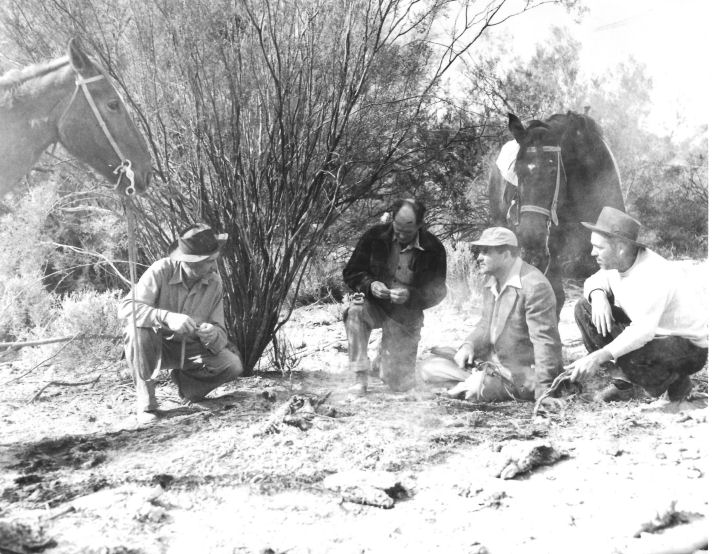
|
Subject: Riders and horses at the mouth of Torpedo Canyon, Hidden Hills Ranch, late 1940s. Left to right: Fred Kennedy, a resident of Sandy
Valley for many years; caretaker of Hidden Hills Ranch (name unknown); Roland Wiley, owner of the Hidden Hills Ranch; a client of Roland Wiley's (name unknown).
|

|
Subject: Buildings located on Roland Wiley's Hidden Hills Ranch, Pahrump Valley, Nevada. The site where the buildings are
located was known by Wiley and others as Dora's Place, where Dora Brown and her family resided. When Wiley purchased the
Hidden Hills Ranch, Dora Brown lived in John Yount's cabin. when Wiley occupied the property in 1941 Dora Brown moved to
the site pictured here. All but one of the buildings pictured were eventually burned down and the willow trees in the
canyon were wiped out in a flash flood in the 1970s. The site was obviously occupied by Indians in previous times, as
evidenced by the holes in rock formations nearby that are 6 to 8 inches in diameter and 12 to 8 inches deep, in which
Indians ground grain. Rider on horse unidentified.
|
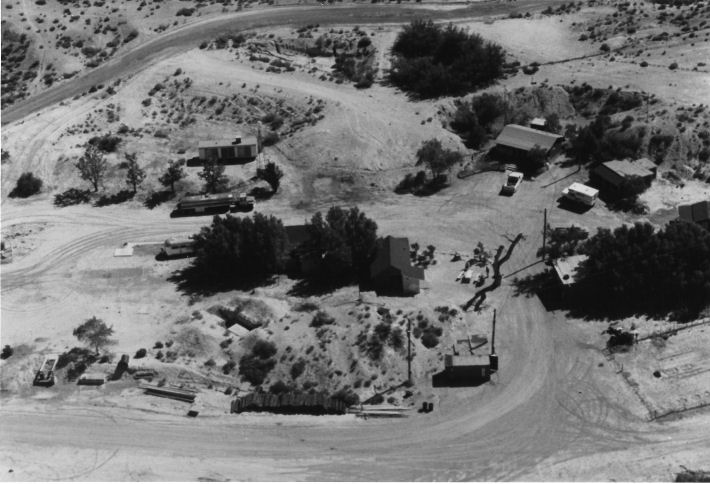
|
Subject: Aerial view of the Hidden Hills ranch, Pahrump Valley, Nevada ca. 1980.
|
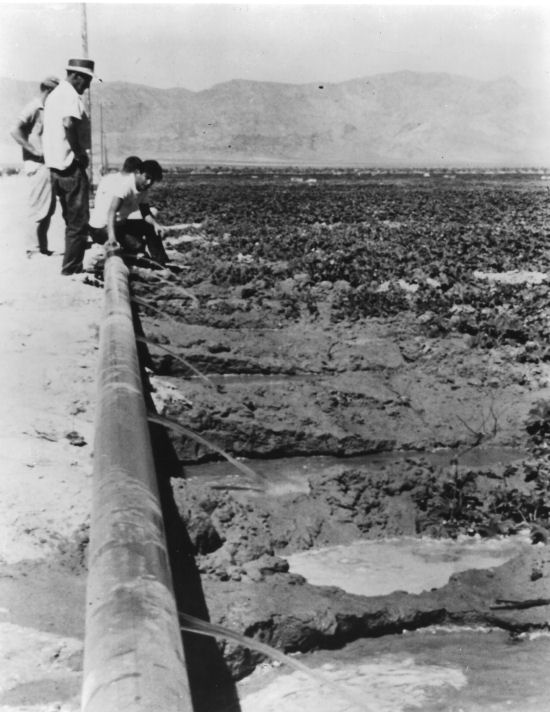
|
Subject: In 1967, 15 acres of Roland Wiley's land holdings on the California side of the Pahrump Valley were planted with melons. The melons,
which thrived on the irrigated land, were sold in Las Vegas, Nevada, and Wiley was paid on the basis that the grower made
$1,000 an acre from the crop. Part of the irrigation system and the crop from that enterprise are shown.
|

|
Subject: Unidentified persons and melons grown on the California side of Roland Wiley's ranch in Pahrump Valley, 1967,
|
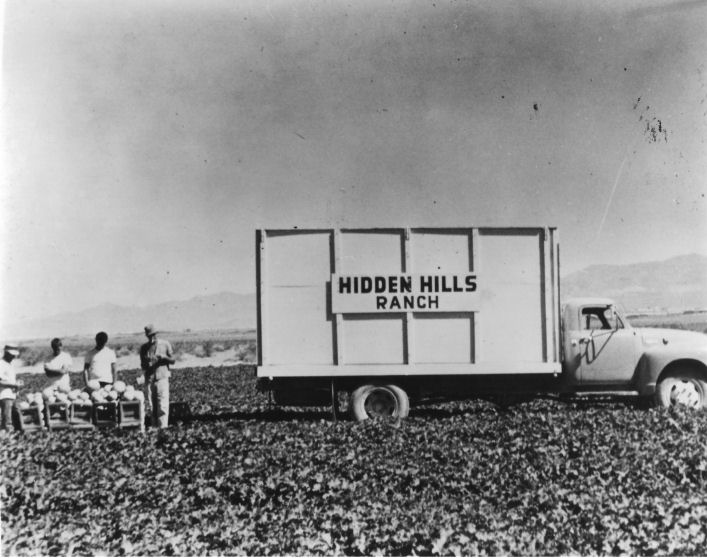
|
Subject: A view of a truck, farm workers, and melons grown on Roland Wiley's Hidden Hills Ranch, Pahrump Valley, Nevada, 1967.
|
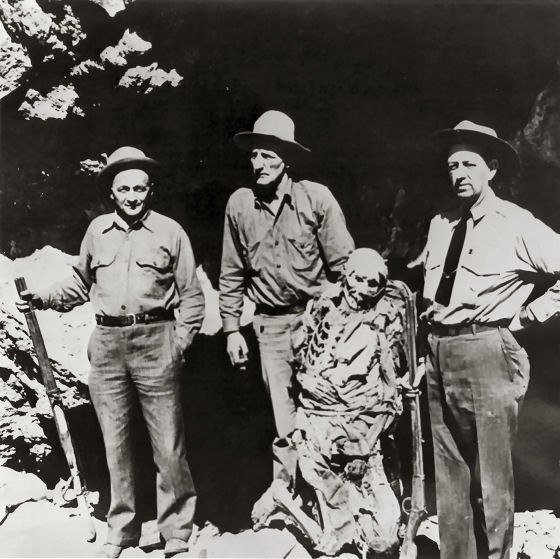
|
Subject: - - Mummified remains of an Indian renegade known as Queho. Many years previous to when this photo was taken in
the early 1940s, Queho is said to have killed and robbed a number of individuals in the Searchlight, Nevada area.
Unsuccessful efforts were made to apprehend Queho. In the early 1940s, the men pictured here on the left and right were
exploring an area along the Colorado River when they saw a cave in the cliffs above the river. they climbed up to the
cave and Queho's remains were found. Research established that the remains were Queho's because several of the artifacts
he had stolen from people in Searchlight accompanied the remains. Queho's remains were turned over to the Palm Mortuary
in Las Vegas when a question arose as to who would pay for the expenses of keeping Queho there and his burial. Roland Wiley,
district attorney for Clark County, Nevada, at the time, suggested that the remains be turned over to the Elks Lodge,
where for a number of years they were exhibited on the Heldorado grounds during Heldorado days in a glass display case
with some of the stolen artifacts. Queho's remains were stolen from the Elks on 2 occasions, and each time they were
recovered. Jim Cashman, head of the Las Vegas Elks at the time, grew tired of worrying about the theft of Queho's remains
so they were moved to a building belonging to Dobie Doc Caudil near the Tropicana Hotel. Roland Wiley purchased Queho's
remains from Dobie Doc for $100 and buried them near Cathedral Canyon, located on Wiley's ranch in Pahrump Valley
overlooking his Hidden Hills airstrip, in concrete and steel so they could not be easily stolen again. Wiley believed the
Indian deserved a decent burial and buried popcorn with the remains to accompany Queho on his journey. Standing second
from the left is Frank Waite, chief of police in Las Vegas for many years. Waite was a member of the posse that initially
searched for Queho.
|
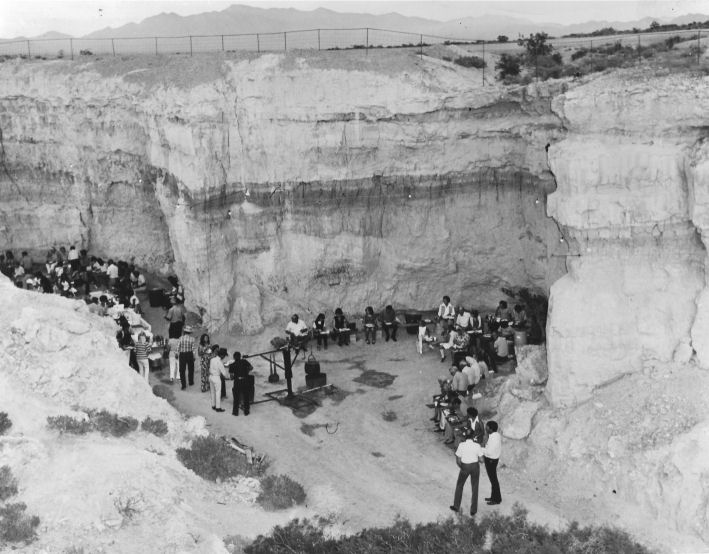
|
Subject: Cathedral Canyon, Pahrump Valley, Nevada, just prior to the canyon's development as a shrine by Roland Wiley, ca. 1971. A few lights
have been strung up and guests have been invited to commemorate the occasion.
|
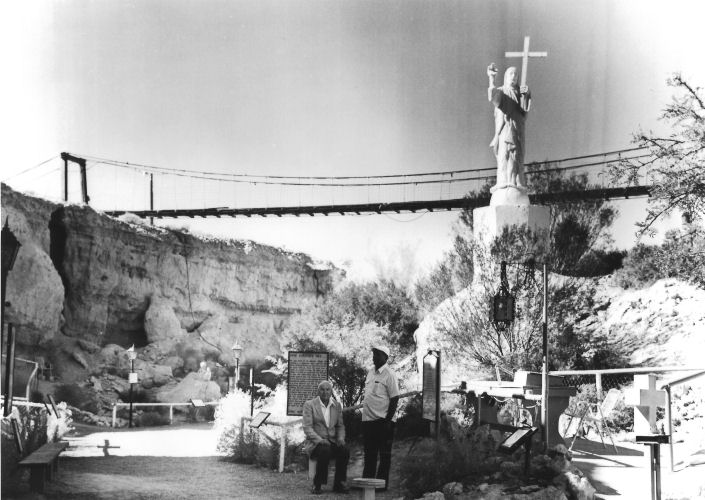
|
Subject: A view of the suspension bridge and the statue of Christ at Cathedral Canyon, Pahrump Valley, Nevada, late 1980s.
The statue, carved of rock, is a small replica of the Christ of the Andes installed in the Andes Mountains on the border
between Argentina and Chile in the early part of the 20th century. The replica was made by an artist from Ajijica, a small
town south of Guadalajara, Mexico. Wiley constructed the suspension bridge about 1973. In 1989, approximately 1,000 people
a month visited Cathedral Canyon. Roland Wiley is seated in the picture; the man standing in the white shirt is unidentified.
|
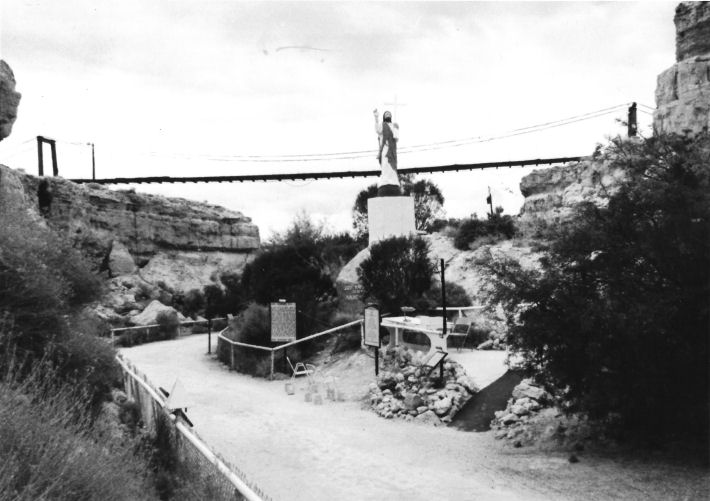
|
Subject: Another view of Cathedral Canyon from the same perspective as Wiley 23.
|
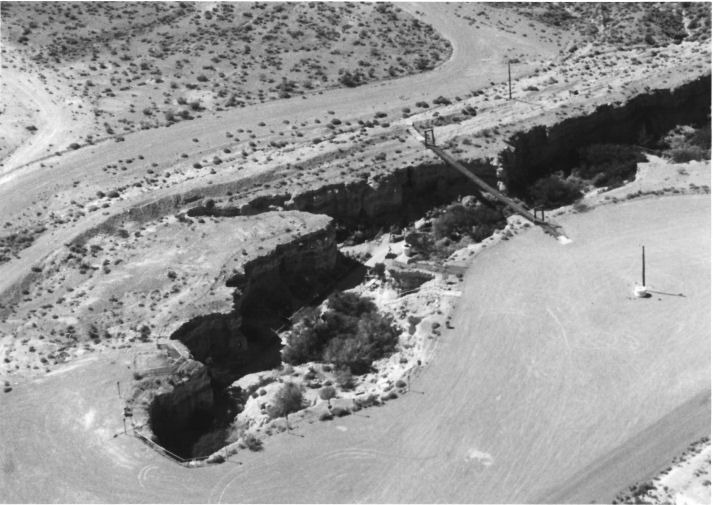
|
Subject: An aerial view of Cathedral Canyon, Pahrump Valley, Nevada, showing the parking lot and suspension bridge. the
walls are about 30 feet high and a recirculating waterfall has been constructed at the head of the canyon. the canyon is
lighted at night. Ca. 1986.
|
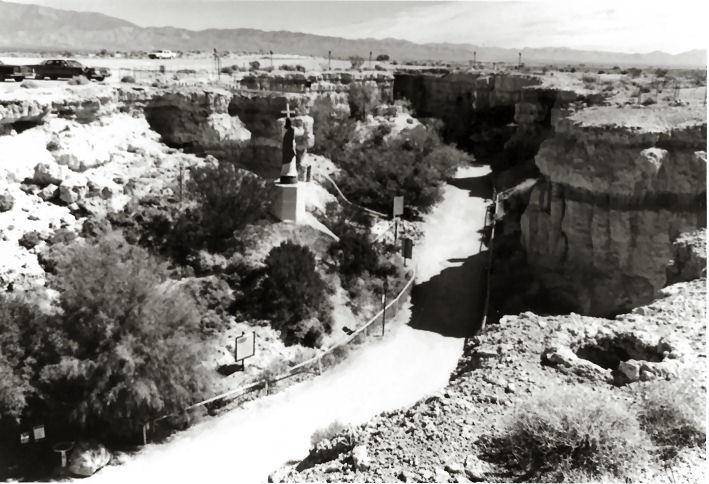
|
Subject: Aerial view of Cathedral Canyon, Pahrump Valley, Nevada, late 1980s.
|
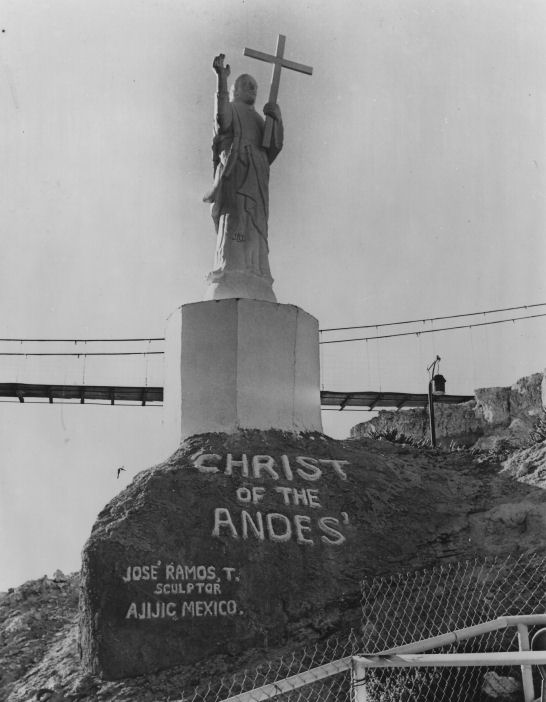
|
Subject: A close up of the Christ of the Andes statue located at Cathedral Canyon, Pahrump Valley, Nevada, ca. 1980.
|
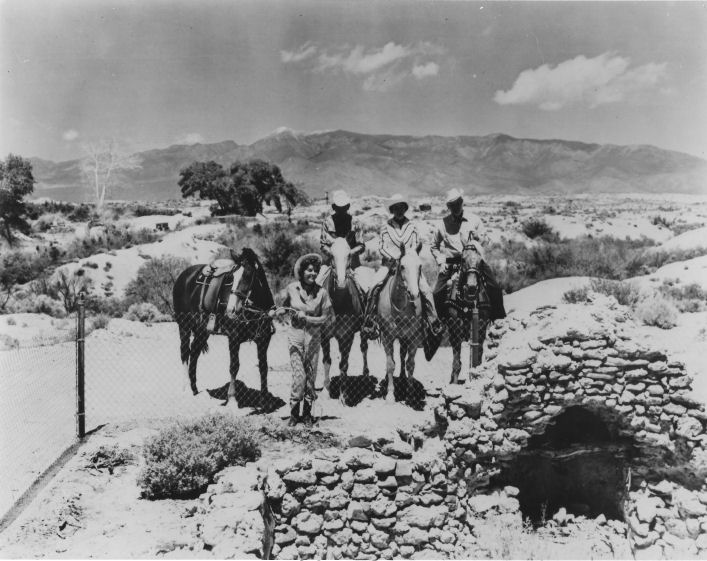
|
Subject: Hidden Hills Ranch, Pahrump Valley, Nevada, circa 1950. the remains of a fireplace believed to have been
constructed by the Indians. Left to right: Ruth Ellerbrook; unidentified; unidentified; Frank Ellerbrook, husband of
Ruth Ellerbrook. Mrs. Ellerbrook was Mrs. America. In the 1930s, Bob Lee, a long-time resident of the Pahrump Valley
area and at that time more than 80 years old, told Wiley that this site and another like it on the Hidden Hills ranch
was in the fallen-down condition seen here when Lee was a small boy. Lee's statement suggests that the fireplace is
more than 120 years old.
|
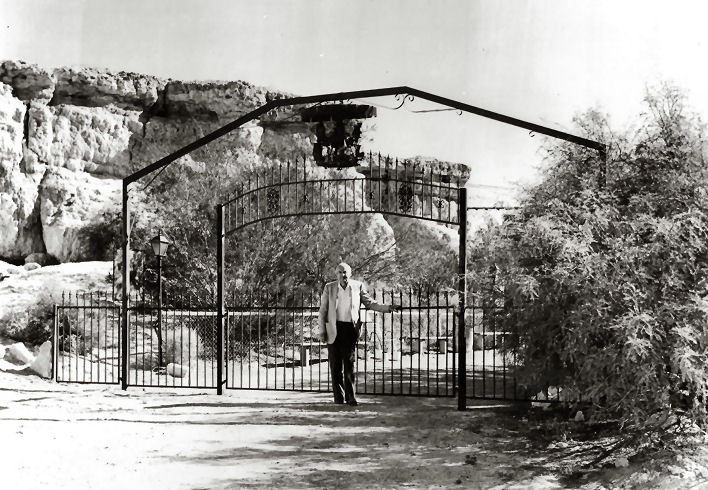
|
Subject: Roland Wiley at the entrance to Cathedral Canyon, Pahrump Valley, Nevada, late 1980.
|
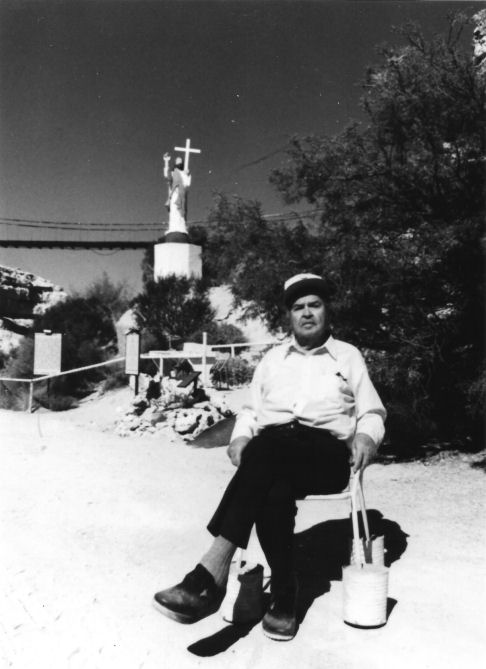
|
Subject: Roland Wiley, the creator and financier of Cathedral Canyon, Pahrump Valley, Nevada (admission is free), seated in the canyon with the suspension bridge and the replica of the Christ of the Andes in the background, 1989.
|
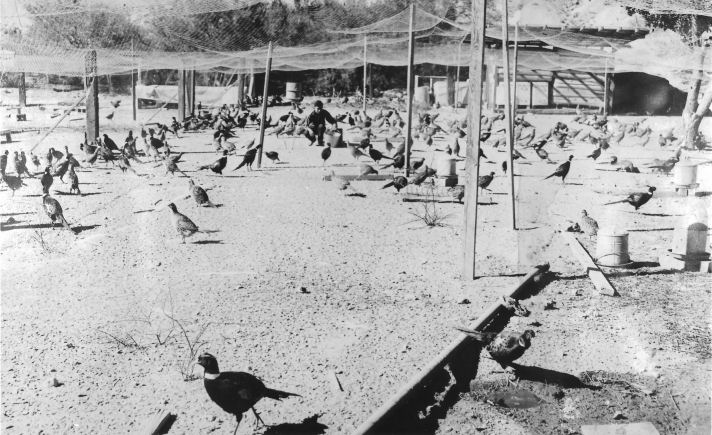
|
Subject: during the early 1950s, Roland Wiley raised pheasants on his Hidden Hills Ranch, Pahrump Valley, Nevada. The birds were turned loose on the property in large numbers and hunted by guests from hotels in Las Vegas and other areas.
Wiley's economic venture in raising pheasants for hunting, however, was not successful.
|































